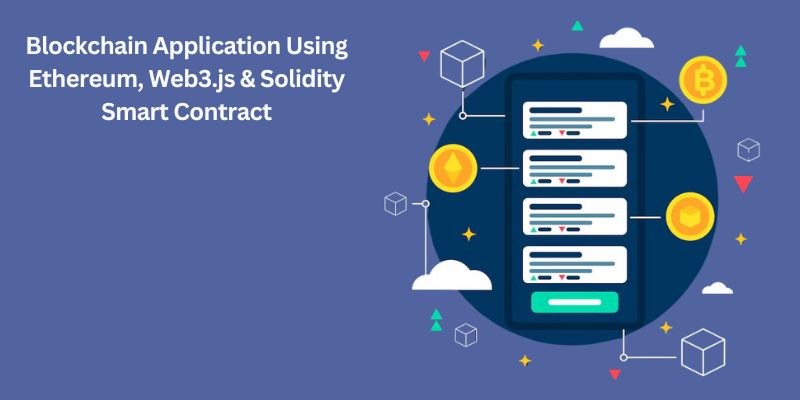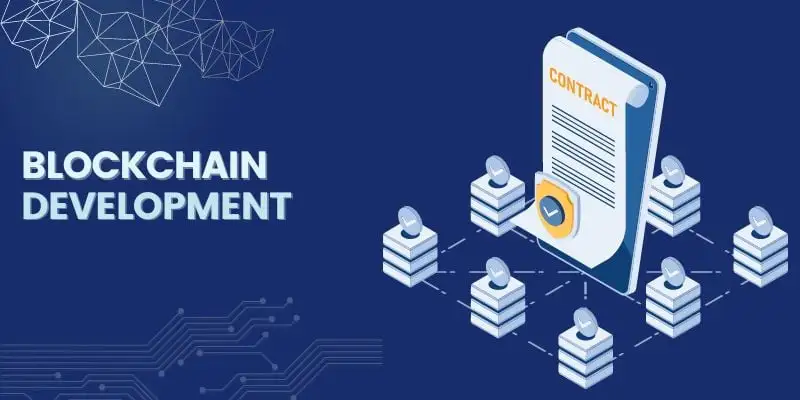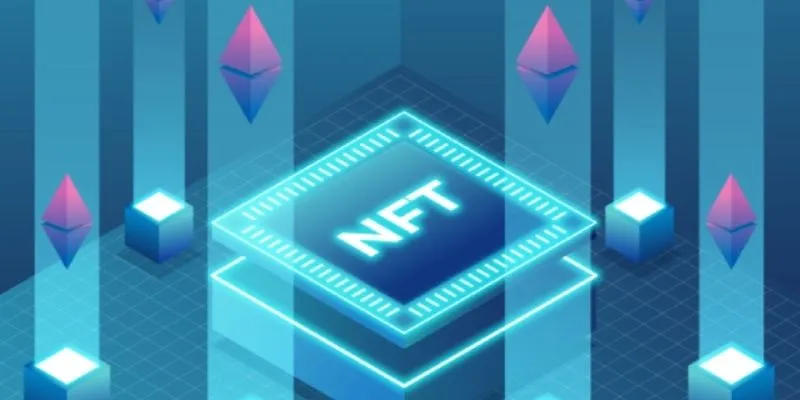Blockchain has recently grown increasingly popular among developers and businesses looking to streamline operations. From peer-to-peer lending platforms and decentralized exchanges on decentralized blockchains to cryptocurrency wallets. Blockchain App Development has revolutionized multiple industries, including supply chain finance and healthcare supply chain systems. If any issues arise when using it, you can consult professionals specializing in Blockchain development solutions.
This blog will outline how to develop blockchain applications using Ethereum, Web3.js, and Solidity smart contracts. There's no need for prior experience, as we will show you how to construct everything from scratch using step-by-step tutorials and detailed instructions. Start building today!
Read About: Custom Blockchain App Development: A Comprehensive Guide for 2024
What Is a Blockchain?
Blockchains are a peer-to-peer network of nodes that communicate with one another. They are basically computers with responsibilities similar to web servers, such as operating programs and storing information that can be accessed whenever you are connected to the e-blockchain. Each node works to build a public network that anyone can join.
One can imagine a blockchain using a variety of ways:
-
A massive worldwide computer made of smaller computers (nodes) working together.
-
Anybody can connect for money transfers or run programs.
Blockchains, however, function differently than traditional web servers. Every bit of information and code in the blockchain development is decentralized, i.e., it's shared across all the network nodes and isn't stored on a central web server. This data consists of several data, known as blocks, which can be linked together to form the public ledger. Each node participating in the network ensures the data is intact and secure. That's why the blockchain is a highly effective system!
Understanding Blockchain Apps
Blockchain-based applications are commonly described as decentralized apps, also known as DApps. DApps rely on blockchain development technology and have distinct features different from conventional applications. They are apps built upon peer–to–peer, decentralized networks. There isn't a central entity or any single point of failure within the blockchain, which could serve as an intermediary between the users who exchange data or funds.
To Create Blockchain Applications, backend programming must be performed using central servers. In contrast to conventional apps, applications that run decentralized execute their backend programming in a peer-to-peer system. From the user's viewpoint, blockchain-based applications appear similar to traditional apps. Blockchain development technology poses no direct threats to individuals. Instead, it's used much like any other app, and its advantages are taken advantage of using its blockchain development features.
Also Read: Guide to Blockchain Application Development : Detailed 2024
How Does a Blockchain Application Work?
Blockchain is a type of network that shares data among its members and stores it in chronologically arranged blocks. It is clear that if something happens on the Blockchain network, it's communicated to all participants, which means that everyone will have an account of the event on their devices. A data blockchain is kept and cannot be removed when a block is added. This makes blockchain one of the more challenging innovations for hacking and stealing data.
Building an online blockchain development requires at least terabytes to gigabytes of storage space. Most DApps run on just one part of the chain because mobile devices only have a small capacity for storage. Based on the type of network, it is possible to classify the blockchain into four different types. We'll look at the four types to better understand.
Read Also: Blockchain Development a Must-Have in the Developer Toolkit
Benefits Of Blockchain Applications

Blockchain-based applications have tangible benefits: they cut businesses' operational expenses and boost users' security and autonomy. They give users greater control of their finances and private information since they no longer have to trust anyone else to protect and keep the information they have. Consider the primary advantages of blockchain-based apps that will attract users' interest.
Transparency
Due to the application's openness, users can learn about a blockchain app anytime. Everything is recorded in the open ledger, which is transparent, which is usually one of the major advantages of using these apps. For example, advancing a blockchain app can aid two businesses interested in collaborating to reach an entirely new height without any extra costs.
Security
Due to the fundamental features of Blockchain Development, a DApp will be more secure than a conventional application by default. Blockchain development integration provides secure security measures and encryption that ensure that data is not erased or forged, and unauthorized updates to the app require the consent of all users using the app.
Lower cost
Blockchain-based applications aim to enhance business processes by eliminating intermediaries or external parties from work procedures. One example is peer-to-peer transactions, which are payments that users directly make with one another through payment services. Thus, using fewer resources can reduce the price of providing the same service.
Refusal To Be Censored
In the absence of a unified administration, it will be difficult for powerful people to regulate the network. They will also not be able to alter systems programmed from outside. Therefore, censorship within the application will not likely be possible.
What Is a Smart Contract?
Smart contracts represent the fundamental foundational elements we utilize to build blockchain-based applications. These programs are written using sources of code that we can deploy onto the blockchain. They're written using the Solidity programming language I'll teach you through this course.
They are impermanent, meaning that once they've been made, they cannot change! When a smart contract has been placed on a blockchain, its code cannot be changed like that of typical software. This is because it's a digital agreement or contract. In the end, you wouldn't wish for any other contract in the real world to be altered after having been made, wouldn't you? One can imagine intelligent contracts as a microservice, or API, available online. If the public ledger functions like a database, smart contracts are the components that read, write, and implement business algorithms.
How Does a Smart Contract Work?
This tutorial will help you write smart contracts to run the market in this course. The smart contract will function sort of like a vending device. Every time someone buys something from the market, they pay Ethereum currency to the smart contract. The smart contract acts as a vending device, selling the product to the purchaser and then transferring the cash payment immediately to the vendor.
Understanding Web3.js
It allows users to connect with Ethereum and other Ethereum-compatible Blockchains, integrate their front-end apps with the Ethereum blockchain, and enable operations like sending transactions, querying data from contracts, and listening for blockchain-related events. Web3.js reduces the difficulty of interacting via the Ethereum network. It removes information at a low level and provides a friendly API to the Core Blockchain Developer. Think of it as a bridge between your front-end code and the Ethereum blockchain.
What Is Solidity?
Solidity is the highest-level programming language created to create smart contracts for the Ethereum blockchain. Smart contracts operate as self-executing agreements with the contract conditions directly incorporated into the coding. Solidity is a statically typed language heavily influenced by JavaScript, Python, and C++.
What Are We Going To Build?
This morning, we'll instruct you on blockchain development programming, beginning from the ground up by building an entire application run by blockchain.
We'll create:
-
Ethereum smart contracts that use Solidity, the Solidity programming language
-
We'll develop tests for smart contracts written in JavaScript
-
We'll add intelligent agreements on a blockchain
The goal is to create a client-side site using Web3.js and React.js that allows users to converse with one another.
Blockchain Marketplace (BPM) provides a marketplace utilizing this revolutionary technology. People can post things for sale, but unlike Craigslist, the website allows users to buy them using cryptocurrency. When someone buys the product, they become its proprietor. This is because the application runs on smart contracts on the blockchain, which controls the market. It determines who owns products for sale and then transfers ownership of the item immediately when someone buys these items with crypto. It functions like a vending machine.
Read About: Complete Guide of Blockchain App Development For 2024
Steps To Build a Blockchain Application Using Ethereum, Web3.js & Solidity Smart Contract

After we've reviewed the fundamentals, let's begin creating an app.
Project Setup
We're going to begin creating the app as quickly as we can! Instead of establishing the app manually, we'll use my basic kit. Start your project by copying this starter kit. Within this project, it is also possible to create smart contracts, evaluate their functionality, and create Web applications with a Front-End Development using Web3.js, React.js, and Bootstrap.
After that, you can proceed to install the dependencies. The file's main function is to link our project with the blockchain network. After we've seen the basic structure of our project, let's begin to write our smart contracts by creating a brand new document in the contracts directory. We'll write our smart contract using the Solidity programming language in this file.
We begin by declaring the version of the Solidity programming language we intend to employ. Next, we declare our smart contract Marketplace. It will include all smart contract codes within these curly braces.
The code generates the "state variable," whose value will be recorded in the blockchain. The variable's name will be used as we'll need to save names for the contract (to test the system). Solidity is a statically typed programming language, so we must define the string's data type before declaring the variable. Then, we make the state variable public so that we can read its value from outside the smart contract, which we'll do in a moment.
It assigns the value of the name within the constructor functions. This specific function is invoked whenever made in the first instance, i.e., deployed onto the blockchain. Once activated, the value of the name will be altered to the value we specified in this.
Let's now compile the smart contract and make sure that it works. Your terminal's output will indicate where the compiled smart contracts can be found! Then, we will implement the smart contract into our Ganache personal blockchain. The file instructs Truffle to add our smart contract to the blockchain. If you're already familiar with this, it's similar to the migration files for an old-fashioned database. Be aware that data files for migration are number-coded to ensure they can be numbered so Truffle can determine which order to use it in. The project is now up and running. Project and added a simple, smart contract to the blockchain!
Let's now write an experiment for intelligent contracts. Testing smart contracts is vital because you must verify that they work flawlessly before deploying them in the blockchain. Be aware that they can't be changed once you have deployed them! It is only possible to deploy a duplicate.
Sell Products
Let's build out the smart contract for marketplaces. The first function we'll develop will permit users to post the item they wish to sell on the market. Solidity lets you create custom data structures that can be filled with attributes. We've achieved this through the creation of a Product structure. It holds all the product characteristics, such as the ID, name, price, owner, and purchase. We'll need to locate a location to store the product on the blockchain.
Mappings are similar to associative arrays or hash tables. They are composed of keys and value pairs. Keys have unique names that provide unique values. In this case, the mapping will use an ID as the key. The value is the Product structure.
In the next phase, Blockchain Software Developers must track the number of items in the smart contract using an itemCount counter cache. The counter cache is used since there's no way to determine how many items are in the mapping other than. Determining a map's "length" or "size" in Solidity is impossible. Therefore, if we wish to retrieve all of the products, we must read each one by one. The counter cache will be used to figure out how many instances to accomplish this.
Buy Products
We can now implement a feature for purchasing items. If someone uses this function, they'll provide the ID of the item they wish to buy (our application for clients handles this). Furthermore, they'll send Ethereum cryptocurrency to their wallet to purchase the product whenever they invoke this function. We have also declared this service payable to accept Ethereum cryptocurrency. You'll be able to see it in action shortly. To make payments to the owner, we need to update the structure and the event to utilize the type of address payable.
Let's finally connect the smart contract to the network so that we can start creating an application for clients to connect to it later. Using the reset flag, we can rerun the migration process to transfer the smart contract onto the blockchain, generating a fresh version of the smart contract in the blockchain.
Must Read: Learn the Basic Concepts Behind Blockchain Technology Now
Considerations To Make In The Development Of Blockchain Apps
One thing to consider when creating an application is that its outcome depends on the tools, technology, platforms, and tools you select. How do you build Blockchain applications with the highest efficiency? The best way to begin the development of blockchain applications is by choosing the right network that supports DApps while looking at the pros and cons of various networks. There are four main aspects to consider when you pick:
Blockchain technology
The key is to determine the popularity of the blockchain and the degree of trust within it. Ethereum is the most well-known, while GoChain and OST have been virtually unexplored.
An OS
It is important to select the kind of application you want to use—mobile, web desktop, or any combination. Also, the operating system you'd like to work on, such as iOS, Android, Mac, Windows, or any combination.
A monetization model
That's how your application earns cash. This could be through selling any assets first introduced to your system, transaction fees, or advertising.
Developers
Blockchain Developers are crucial in making your blockchain application run smoothly. Therefore, you must hire professionals to create the correct smart contract software using a high-level programming language.
Wrapping up
The key ideas and top practices for creating DApps range from writing smart contracts with Solidity to constructing the front-end user interface. You've also learned about security. DApp development is an ever-changing field, and being up to date with the latest developments in blockchain development technology and best practices is crucial. Keep exploring and testing blockchain development to build powerful and innovative decentralized apps.
DApp development involves technological skills, imagination, user security, and experience dedication. If you're developing financial apps such as decentralized games or another type of DApp, your contributions to the blockchain ecosystem could influence the direction of decentralized technology.
This guide should have addressed all of your concerns concerning the design of a blockchain app. If you know how to develop a blockchain application, you can determine if it suits you. The demand for DApps is because the technology offers a variety of advantages, such as accessibility, security, transparency, and cost-saving.














Share this blog